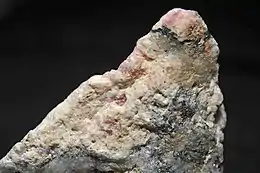Tugtupite
Tugtupite is a beryllium aluminium tectosilicate. It also contains sodium and chlorine and has the formula Na4AlBeSi4O12Cl.[2] Tugtupite is a member of the silica-deficient feldspathoid mineral group. It occurs in high alkali intrusive igneous rocks.
| Tugtupite | |
|---|---|
 | |
| General | |
| Category | Tectosilicate |
| Formula (repeating unit) | Na4(AlBeSi4O12)Cl |
| Strunz classification | 9.FB.10 |
| Crystal system | Tetragonal |
| Crystal class | Disphenoidal (4) H-M symbol: (4) |
| Space group | I4 |
| Identification | |
| Color | White, pink, crimson, blue, green |
| Mohs scale hardness | 4 |
| Luster | Vitreous |
| Specific gravity | 2.36 |
| References | [1] |
Tugtupite is tenebrescent, sharing much of its crystal structure with sodalite, and the two minerals are occasionally found together in the same sample.
Tugtupite occurs as vitreous, transparent to translucent masses of tetragonal crystals and is commonly found in white, pink, to crimson, and even blue and green. It has a Mohs hardness of 4 and a specific gravity of 2.36. It fluoresces crimson under ultraviolet radiation.
It was first found in 1962 at Tugtup agtakôrfia Ilimaussaq intrusive complex of southwest Greenland.[3] It has also been found at Mont-Saint-Hilaire in Quebec and in the Lovozero Massif of the Kola Peninsula in Russia
The name is derived from the Greenlandic Inuit word for reindeer (tuttu), and means "reindeer blood."[4]
The U.S. Geological Survey reports that in Nepal, tugtupite (as well as jasper and nephrite) were found extensively in most of the rivers from the Bardia to the Dang.[5]
It is used as a gemstone.[6]
References
| Wikimedia Commons has media related to Tugtupite. |
- Mineralienatlas
- "Tugtupite: Tugtupite mineral information and data". Mindat.org. Retrieved 16 May 2011.
- "Tugtupite Mineral Data". Webmineral.com. Retrieved 16 May 2011.
- "Gems In Them Thar Hills!". Athropolis.com. Retrieved 17 May 2011.
- Johnson, Gabe (October 2006), 2006 Minerals Yearbook (PDF), United States Geological Survey, p. 5, retrieved 17 May 2011
- Gemstones: Properties, Identification and Use By Arthur Thomas